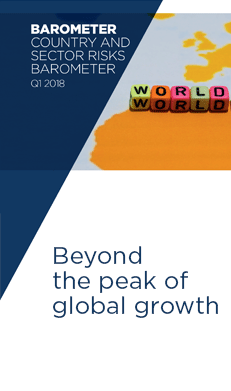Insolvent or ‘zombies’, distressed companies represent nearly 6% of the total in France

- Fewer and fewer insolvencies: down 8.3% at end-January 2018 over one year and a forecast of -3.6% in 2018
- Smaller businesses are doing well, others even better
- The insolvency rate is now lower than the pre-crisis rate
- However, the picture is far from idyllic because the number of so-called ‘zombie’ companies, which are still alive but are insolvent and unprofitable, remains high
Fewer insolvencies, but the momentum is expected to slow in 2018
The beginning of the year marked a clear improvement in key business insolvency indicators. There was an 8.3% drop in the number of business insolvencies to 53,414 cases over one year in January 2018, which is the lowest since October 2008. Their cost to the economy is experiencing a double-digit drop: -15.2% for supplier debt (3.2 billion euros) thanks to the dynamism of the largest businesses and -15.4% for the number of jobs affected (156 673).
The stronger growth (2% in 2017) benefited all types of businesses, all regions, and the majority of sectors.
- Although the insolvency rate of very small enterprises which make less than €250 000 turnover has fallen to under the France's national average (-5,2% vs -8,3%), that of companies with a turnover of over one million euros has dropped by 24.2%, mainly as a result of the recovery in world trade.
- After four consecutive years of increase, the situation in Ile-de-France (which concentrates over 20% of insolvencies) is finally benefiting from the general improvement.
- The construction sector (-13% in one year) represents 50% of the drop in business insolvencies as a result of very low interest rates and consumer confidence at the highest since the crisis. This is also the case for sectors driven by dynamic consumer consumption, such as clothing (-13%), personal services (-6.4%, drop supported by catering) and automotive (-5.4%). In the agrofood sector, the situation is more mixed (-0.9% only) due to poor cereal harvests in 2016 which resulted in a wave of business insolvencies among grain farmers, bakers and pastry chefs.
‘Coface expects a less marked decline in business insolvencies in 2018: -3.6% after -7.3% over the whole of 2017. This less sustained pace is partly due to the likely slowdown in French activity in the second half of the year because of recruitment and supply constraints, and the first signs of a slow down are already visible in the construction sector.’ said Bruno de Moura Fernandes, economist at Coface.
‘Zombie’ companies, a symptom of continuing imbalances in the economy
Although the number of business insolvencies remains higher than pre-crisis, the insolvency rate is lower (1.14% in 2016 against 1.35% in 2007) due to a larger stock of companies. It is comparable to that recorded in Germany (1.2%) while in Italy and Spain the very long and costly procedures pushing companies to resort to other alternatives (voluntary liquidation, mortgage financing) have resulted in a sub-evaluation of the insolvency rate at 0.3% and 0.1% respectively.
However, the situation of French companies is more contrasting than the drop in the number of failures suggests. If we add unprofitable and insolvent ‘zombie’ companies (4.6% of the total number, according to Coface's estimates) to the insolvency rate, the share of distressed companies is 5.7% of the total number of business (as at end-2016). Since the end of the crisis, the number of ‘zombie’ companies, which are artificially kept alive by low-cost financing in a context of an expansionary monetary policy, has not dropped in France, while in Spain, which was very much affected by the crisis, it began to drop in 2013.
‘Since the end of the crisis, there are fewer business solvencies in France but just as many zombie companies, which is consistent with the relatively weak growth recorded up to 2016. This increase in zombie companies, which could go bankrupt at any time, is detrimental to the economy because it hampers the creative destruction process and drives the productivity of a country down.’ said Bruno de Moura Fernandes.
Download the publication
- Overall trend
- Sectorial dynamics
- Regional dynamics
- Zombies and insolvencies





